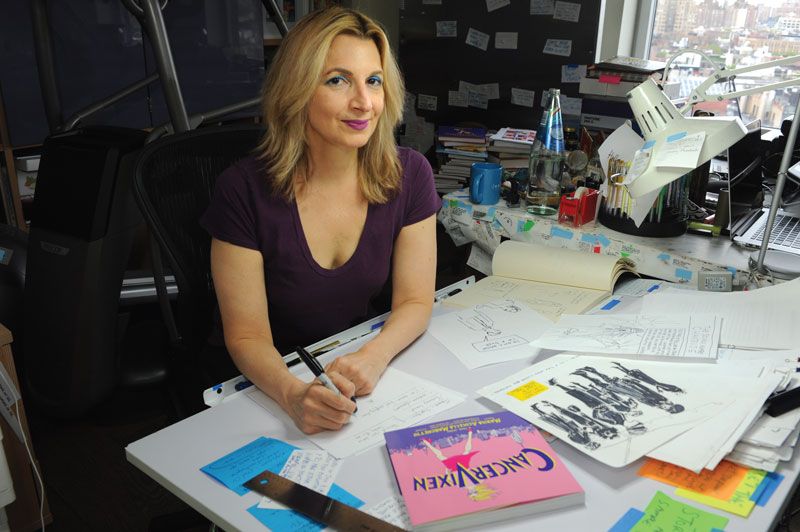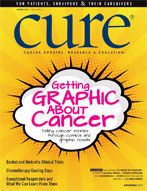Publication
Article
CURE
Getting Graphic About Cancer
Author(s):
Telling cancer stories through comics and graphic novels can be therapeutic for writers, illustrators and their audiences.
MARISA ACOCELLA MARCHETTO felt there was no better way to describe her cancer journey than through a graphic novel, Cancer Vixen.- PHOTO BY SUSAN FARLEY

MARISA ACOCELLA MARCHETTO felt there was no better way to describe her cancer journey than through a graphic novel, Cancer Vixen.- PHOTO BY SUSAN FARLEY
When illustrator Marisa Acocella Marchetto was diagnosed with breast cancer in May 2004, her editor at Glamour magazine asked if she would like to write about it. Acocella Marchetto immediately said yes.
Over the next 11 months, she diligently documented the physical and emotional ups and downs of her treatment journey via sketches, photos and tape recordings. “Sketching to me is kind of a nervous tic,” Acocella Marchetto says. “I’m always drawing.” The resulting chronicle was a six-page graphic memoir titled “Cancer Vixen.”
The New York Times profiled Acocella Marchetto when the issue of Glamour featuring “Cancer Vixen” hit the stands, and it wasn’t long before book publishers came calling. Acocella Marchetto signed with Alfred A. Knopf and expanded “Cancer Vixen” into a 212-page hardcover graphic novel, later republished in paperback by Pantheon Books.
With the publication of “Cancer Vixen,” Acocella Marchetto joined a growing number of cartoonists and illustrators who have chosen to tell their cancer stories through a medium associated by many with spandex-wearing superheroes. However, in recent decades, the graphic novel has matured into a powerful and evocative form of storytelling, especially when the subject is as life-changing as a diagnosis of cancer.
It’s a medium that can prove therapeutic not only for those who create the works, but for readers who can relate to the storylines because of their own experiences with cancer.
NOT EXACTLY THE "FUNNY PAGES"
Cancer may not seem like an acceptable topic for comics, but many of the medium’s most popular creators would disagree. Tom Batiuk, the creator of the daily comic strip "Funky Winkerbean," which boasts an estimated 50 million readers, wrote two separate storylines involving character Lisa Moore’s experience with breast cancer. In the first, Lisa went through a grueling treatment regimen that included a mastectomy, but ultimately survived the ordeal. Several years later, she was devastated to learn that her cancer had returned. She fought as hard as she could, becoming a vocal advocate for cancer research in the process, but ultimately lost her battle. Batiuk’s syndicate supported his decision to have Lisa die, but many readers were outraged, telling the cartoonist they felt betrayed.
More recently, comic book writer Jason Aaron incorporated breast cancer into the storyline of "Thor," one of Marvel Comics’ most popular titles. The original Thor was found unworthy of wielding the mighty Mjolnir (Thor’s hammer), and the mantle was passed to Dr. Jane Foster, Thor’s ex-girlfriend. But there’s a catch: Foster is battling breast cancer, and every time she transforms into the Asgardian superhero, her condition worsens.
GETTING GRAPHIC ABOUT CANCER
Cancer has only occasionally been addressed in comic strips and comic books, but is the subject of a surprising number of graphic novels. Among the first was “Our Cancer Year,” written by Harvey Pekar and Joyce Brabner and illustrated by Frank Stack. Published in 1994, the book-length comic explores a difficult year in the couple’s life, including Pekar’s battle with lymphoma and Brabner’s struggles as his overwhelmed caregiver.
“Our Cancer Year” won the 1995 Harvey Award for best graphic novel and opened the door for others to come, including “Mammoir: A Pictorial Odyssey of the Adventures of a Fourth Grade Teacher With Breast Cancer,” by Tucky Fussell (2005); “Cancer Made Me A Shallower Person: A Memoir In Comics,” by Miriam Engelberg (2006); “Mom’s Cancer,” by Brian Fies (2006); “Cancer Vixen” (2006); “Relatively Indolent But Relentless: A Cancer Treatment Journal,” by Matt Freedman (2014); “Probably Nothing: A Diary of Not Your Average Nine Months,” by Matilda Tristram (2014); and “The Story of My Tits,” by Jennifer Hayden (2015).
JENNIFER HAYDEN saw her graphic novel as 'a vessel that would hold all my life.'

JENNIFER HAYDEN saw her graphic novel as 'a vessel that would hold all my life.'
Connected only by their subject matter, each book explores the cancer journey in unique and individual ways. “Cancer Vixen,” for example, is specific to Marchetto’s experience with breast cancer; it begins with the discovery of a lump in her chest and concludes with the successful completion of her treatment. “Mom’s Cancer,” which originated as a serialized online comic, is the story of Fies’ mother’s battle with lung cancer with metastases to the brain, told from Fies’ perspective as her oldest child. In “Mammoir,” Fussell incorporates a touch of fantasy as she relates the story of her breast cancer. And “The Story of My Tits” is a full-on autobiography that includes, among other incidents, Hayden’s diagnosis of breast cancer and her decision to undergo a bilateral mastectomy.
“I serialized Mom’s Cancer online because I wanted to get the story out, it was easy and cheap, and I didn’t know how else to do it,” says Fies of his decision to tell his story in cartoon form. He landed a book deal with Abrams ComicArts after “Mom’s Cancer” was nominated for an Eisner Award, named after artist Will Eisner, widely acknowledged as the father of the contemporary graphic novel.
Hayden went the graphic novel route because she didn’t consider herself a good enough writer to relate her story as a journalistic work of nonfiction. “When I started reading graphic novels, I realized that this, to me, was a vessel that would hold all my life,” she explains. “I thought it was the only way to tell abreast cancer story in which I could be funny and sad and silly — everything I wanted to be.” Before putting pen to paper, Hayden spent a year reading a wide variety of graphic novels. It took her another eight years to write and draw “The Story of My Tits.”
The time-consuming process of writing and illustrating their stories ran the creators through a gauntlet of emotions, though most found the experience cathartic. “I hadn’t intended 'Mom’s Cancer' to be therapeutic for me, but it was,” observes Fies. “Telling our story made me a careful observer and note taker. No matter what happened, I always had another pair of eyes watching dispassionately over my shoulder. It gave me an outlet to express my worry and stress. It also gave me control over something, when so much else was out of my control. I couldn’t heal Mom, but I could tell her story as best I could.”
Reports Fussell, “Writing and drawing ‘Mammoir’ was very cathartic, yet also very difficult. Still reeling from having been fired from my job as a teacher, I started to relax into the experience of writing and drawing daily. Probably the hardest part was publishing and publicizing the book.”
Acocella Marchetto also found the process therapeutic. “Instead of internalizing the experience, I was externalizing it and putting it on the page, finding the humor and making myself laugh,” she says. “I thought if I could make myself laugh, I could make other people laugh.”
SHARED TRUTHS
Acocella Marchetto is somewhat unique regarding the humor she presents in “Cancer Vixen,” much of which derives from interactions with her mother (whom she calls Smother), friends and others. In contrast, there’s no humor to be found in Pekar and Brabner’s “Our Cancer Year.” The story unflinchingly shows the couple’s relationship in a downward spiral as Pekar suffers through a debilitating treatment regimen and Brabner deals with difficult issues in her own life. Yet, while very different in tone and style, “Cancer Vixen” and “Our Cancer Year” equally explore their individual cancer stories in a deeply personal and heartfelt manner.
The one thing almost all graphic novels about cancer seem to have in common is the no-holds-barred way in which they describe the cancer experience. It’s all on the page: the good, the bad and the ugly. “I just think, if you’re not going to tell the truth, why bother?” says Acocella Marchetto. “People respond to authenticity, and I don’t like it when I’m reading something and I feel like the author is withholding the truth.”
Fies agrees, noting, “I knew the story would only be worthwhile if I were as honest as I could be. It’s the difference between making up a story and reporting on something you’ve lived. Real life provides textures that only someone who’s been through it would catch and relate to. That was the point of doing ‘Mom’s Cancer’ — sharing our experiences, drawing a map for someone following us down the same path.”
Not everyone may be comfortable with that level of disclosure, though, so prospective readers need to consider whether they’ll feel empowered or frightened by naked honesty about the most difficult details of a cancer journey. Fussell faced questions about that issue as she worked to get “Mammoir” published, and was told by an editor that her artwork was too “real” and might make people uncomfortable. The conversation only left her more convinced that readers would benefit from her book.
BRIAN FIES was gratified to learn that his book was being used to teach nurses about family dynamics during the cancer experience.

BRIAN FIES was gratified to learn that his book was being used to teach nurses about family dynamics during the cancer experience.
Hayden has heard similar sentiments. “One reader said in a review online that, though she’d liked my book, passages about the cancer almost made her pass out,” she recalls.
Like Fussell, Hayden read that as a confirmation of the power of the graphic novel. “It is graphic,” she says, “and, in that sense, it can get more into the nitty gritty of a physical experience than just plain writing can.”
Creating a book-length memoir in graphic form is never easy, but the challenges are significantly more when the story is about cancer, especially your own. Acochella Marchetto, for example, says her greatest challenge was staying awake at the drawing board on the days she received chemotherapy.
Hayden’s challenge was chronicling certain negative relationship experiences that occurred during her life. By comparison, she says, writing about her cancer was far less stressful. “I was living with ghosts and reviving them,” she explains. “When I got to the breast cancer part of the story, it was a relief. It was easier than writing about my mother’s illness, my parents’ marriage or my relationship with my father. All of that really hurt.”
REACHING READERS
Ultimately, the heartfelt, honest and factually accurate nature of the books has resonated strongly with readers. “I still get letters about it,” reports Acocella Marchetto, who has donated profits from the book to her Marisa Acocella Marchetto Foundation, based at the Mount Sinai Beth Israel Comprehensive Cancer Center West in New York, which has raised $1 million so far to help empower and care for uninsured and underinsured women with breast cancer. “I feel like it’s an ongoing story because cancer is an ongoing issue. Also, it’s a tale of hope and positivity and inner strength. It’s a story (showing that) how you perceive yourself can affect your outcome.”
Fies notes that one of the first emails he received regarding “Mom’s Cancer” was from a nursing instructor in Australia who wanted to include pages from the online series in her coursework. “She wanted her students to understand some of the family dynamics they might face when serving remote communities in the Outback,” he says. “That blew me away. I intellectually understood the instantaneous worldwide reach of the Web, but hearing from someone like that on literally the other side of the planet was powerful. These stories are universal in ways I didn’t suspect.”
“I’ve had women write and say, ‘I’ve just come home from my mastectomy and I’m reading your book and feeling so much better,’” adds Hayden. “I think women read ‘The Story of My Tits’ and feel as if there’s a sisterhood out there. (A close friend) who recently received a bilateral mastectomy read the book and said it gave her a sense of solidarity and power, and made her realize it wasn’t the end of the world.”
INSPIRING WRITERS
Patients who gain that feeling of kinship and catharsis by reading such works may find themselves inspired to write about their own cancer experiences, something many experts agree can be a valuable therapeutic exercise.
With many cancer patients turning to personal journaling as they struggle with the ups and downs of their medical journeys, a growing number of hospitals and cancer centers around the United States have instituted writing programs specifically designed to help patients cope with their disease and treatment. Smilow Cancer Hospital at Yale-New Haven, in Connecticut, offers one such program. Launched in 2013, it is run by Charlotte Evans, a retired writer and editor with The New York Times, and directed by Dana Shaffer, coordinator of the hospital’s Complementary Services Art Program. Another program, Visible Ink, through which patients with cancer can work individually with writing mentors, is run by Memorial Sloan Kettering Cancer Center, in New York.
“I’ve always felt that writing could be a useful tool to get you through a difficult time, and there is a lot of evidence to support the theory that writing is helpful,” observes Evans, who leads the weekly classes at Smilow.
Evans begins each session with a segment she calls “Ripped From the Headlines,” in which she discusses recent newspaper, magazine and television items related to cancer. A discussion about the writing process is next, followed by patients reading their most recent essays, which are written at home.
“The expectation is that everyone will read,” Evans says. “It’s a privilege to sit and listen to others read about something so intimate, so it’s only fair that everybody take a turn.” Afterwards, participants offer comments and constructive criticism.
According to Evans, patients can write about anything they wish, but, almost always, their work comes back to their cancer and treatment. As to why patients join the program, she observes, “I think from a layman’s perspective, people just want to tell their stories. But beyond that, it’s a way of getting out something that is troubling them. They are afraid. They are in pain. Some of them have written about their fear of dying or the impact of their disease on family and others. I think it’s helpful for them to be able to get this out in a safe setting.”
Based on her experience at Smilow Cancer Hospital, Evans encourages patients to participate in a writing program if it’s available at their treatment center.
“I would say give it a try, because you may not know what’s inside you that wants to get out in word form,” she says. “With proper feedback, you can write, even though you don’t think you can, and you might surprise yourself as to what comes out on paper.”






